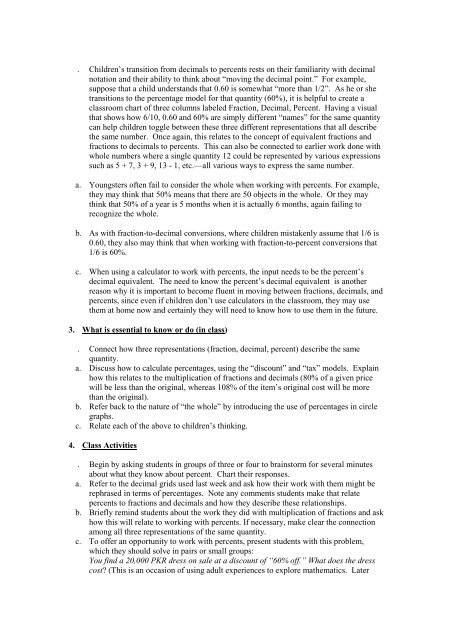Course Guide - USAID Teacher Education Project
Course Guide - USAID Teacher Education Project
Course Guide - USAID Teacher Education Project
You also want an ePaper? Increase the reach of your titles
YUMPU automatically turns print PDFs into web optimized ePapers that Google loves.
. Children’s transition from decimals to percents rests on their familiarity with decimalnotation and their ability to think about “moving the decimal point.” For example,suppose that a child understands that 0.60 is somewhat “more than 1/2”. As he or shetransitions to the percentage model for that quantity (60%), it is helpful to create aclassroom chart of three columns labeled Fraction, Decimal, Percent. Having a visualthat shows how 6/10, 0.60 and 60% are simply different “names” for the same quantitycan help children toggle between these three different representations that all describethe same number. Once again, this relates to the concept of equivalent fractions andfractions to decimals to percents. This can also be connected to earlier work done withwhole numbers where a single quantity 12 could be represented by various expressionssuch as 5 + 7, 3 + 9, 13 - 1, etc.—all various ways to express the same number.a. Youngsters often fail to consider the whole when working with percents. For example,they may think that 50% means that there are 50 objects in the whole. Or they maythink that 50% of a year is 5 months when it is actually 6 months, again failing torecognize the whole.b. As with fraction-to-decimal conversions, where children mistakenly assume that 1/6 is0.60, they also may think that when working with fraction-to-percent conversions that1/6 is 60%.c. When using a calculator to work with percents, the input needs to be the percent’sdecimal equivalent. The need to know the percent’s decimal equivalent is anotherreason why it is important to become fluent in moving between fractions, decimals, andpercents, since even if children don’t use calculators in the classroom, they may usethem at home now and certainly they will need to know how to use them in the future.3. What is essential to know or do (in class). Connect how three representations (fraction, decimal, percent) describe the samequantity.a. Discuss how to calculate percentages, using the “discount” and “tax” models. Explainhow this relates to the multiplication of fractions and decimals (80% of a given pricewill be less than the original, whereas 108% of the item’s original cost will be morethan the original).b. Refer back to the nature of “the whole” by introducing the use of percentages in circlegraphs.c. Relate each of the above to children’s thinking.4. Class Activities. Begin by asking students in groups of three or four to brainstorm for several minutesabout what they know about percent. Chart their responses.a. Refer to the decimal grids used last week and ask how their work with them might berephrased in terms of percentages. Note any comments students make that relatepercents to fractions and decimals and how they describe these relationships.b. Briefly remind students about the work they did with multiplication of fractions and askhow this will relate to working with percents. If necessary, make clear the connectionamong all three representations of the same quantity.c. To offer an opportunity to work with percents, present students with this problem,which they should solve in pairs or small groups:You find a 20,000 PKR dress on sale at a discount of “60% off.” What does the dresscost? (This is an occasion of using adult experiences to explore mathematics. Later
















